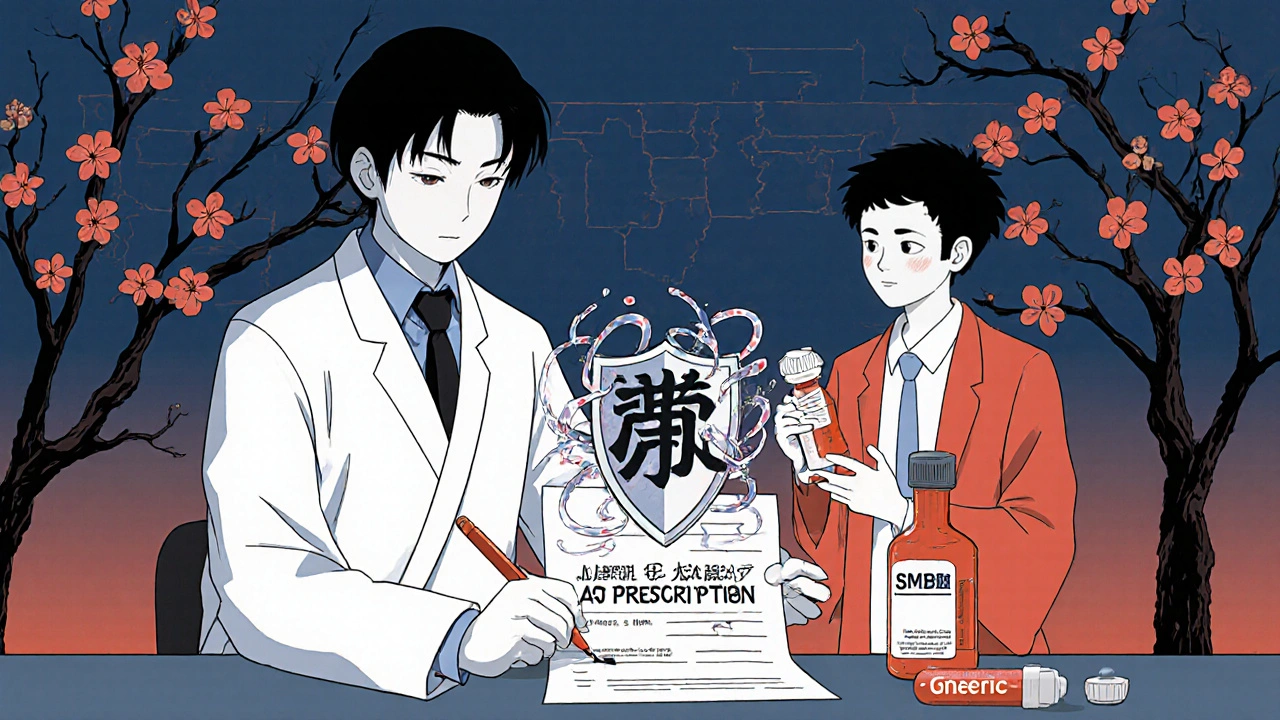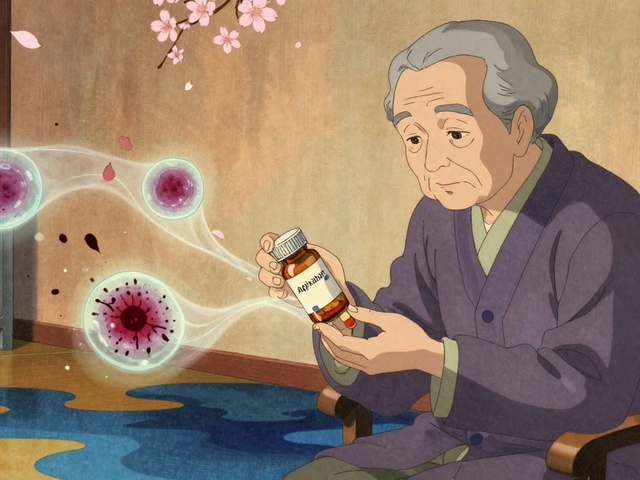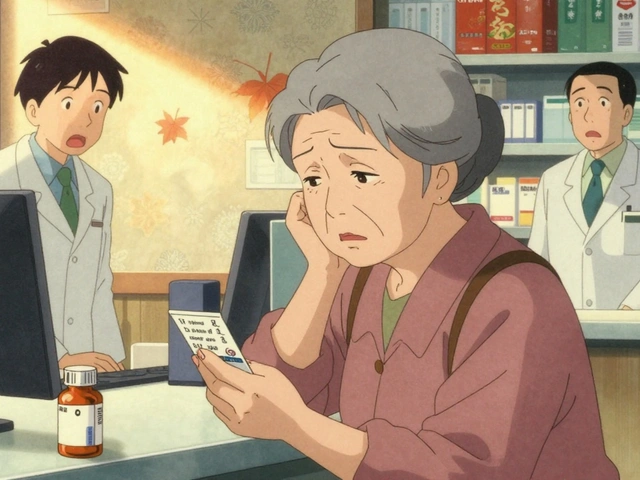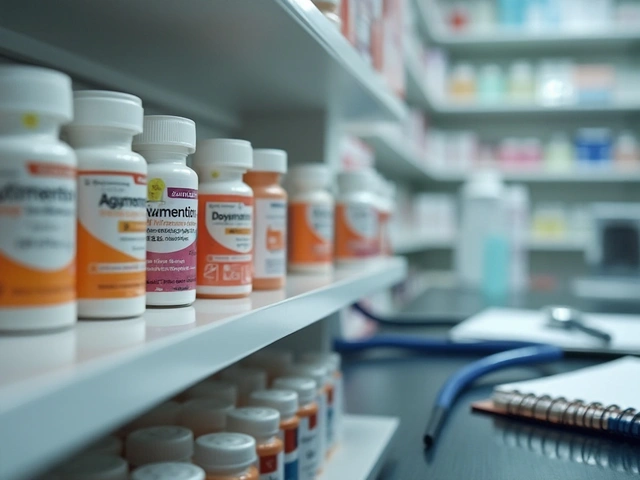When your prescription comes back from the pharmacy and you see a different name on the bottle than what your doctor wrote, it’s not a mistake. It’s generic substitution - and it’s happening more than ever. In the U.S., about 90% of prescriptions filled today are for generic drugs. That’s not because doctors are pushing them - it’s because insurance companies are making them the default. But what happens when that switch doesn’t work for you? How do you push back? And more importantly, how do you actually get the brand-name drug you need without paying hundreds extra?
Why Insurance Companies Push Generic Substitution
Insurance plans don’t just encourage generics - many force them. Why? Because the numbers don’t lie. A brand-name drug like Lipitor might cost $150 a month. The generic, atorvastatin? Around $10. That’s a 93% drop in cost. For insurers, it’s not about being cheap - it’s about keeping premiums down for everyone. The FDA says generics have the same active ingredient, strength, and dosage as the brand. They’re required to be bioequivalent: meaning they deliver the same amount of drug into your bloodstream within a narrow range (80-125% of the brand). For most people, that’s enough. But here’s the catch: bioequivalence doesn’t mean identical. Inactive ingredients - the fillers, dyes, and coatings - can vary between manufacturers. For someone with a sensitive stomach, a dairy allergy, or a rare reaction to a dye, that difference can matter. And for drugs with a narrow therapeutic index - like warfarin, lithium, or levothyroxine - even tiny changes in absorption can cause serious side effects.How Substitution Works (And When It’s Forced)
In most states, pharmacists are allowed - or even required - to swap a brand-name drug for a generic unless the doctor says “Do Not Substitute” or “Dispense as Written.” But here’s where it gets messy: many doctors don’t write that. And many patients don’t know they have a right to refuse. In 19 states, pharmacists must substitute unless the prescription says otherwise. In 7 states and D.C., they need your explicit consent. In 31 states, they have to tell you they’re switching - even if you don’t say anything. And in 24 states, pharmacists face no extra legal risk if something goes wrong after a substitution. That means if you end up with bad side effects, the pharmacy might not be held liable. Insurance companies often make substitution automatic. If you’re on a plan from Sun Life or Great West Life in Canada, or Blue Cross in Michigan, your insurer will only pay for the generic. If you want the brand, you pay the difference out of pocket. Some plans go further: they’ll refuse to cover the brand at all unless your doctor files a prior authorization request proving the generic didn’t work.When You Need the Brand - And How to Get It
You don’t have to accept a substitution if it’s not right for you. The law gives you the right to ask for the brand-name drug. But you need to know how to make it happen. The first step? Talk to your doctor. If you’ve had issues with a generic - whether it’s mood swings, nausea, or lab results that don’t match - ask them to write “Dispense as Written” or “Brand Medically Necessary” directly on the prescription. This is the most reliable way to block substitution. In Texas, for example, if the doctor writes “Brand Medically Necessary,” the pharmacy cannot substitute - even if the insurance says to. But doctors aren’t always sure how to do this. Many don’t know the exact wording insurers require. Some need ICD-10 codes showing therapeutic failure. Aetna wants three specific clinical reasons. UnitedHealthcare wants five. Blue Cross of Michigan approves 78% of requests when proper documentation is submitted. But if your doctor’s office doesn’t know the rules, your request gets denied. The second step? Talk to your pharmacist. Ask them if the generic you got is from the same manufacturer as the brand. Different generic makers use different inactive ingredients. One batch might be fine. Another might trigger a reaction. If you’ve had a bad experience before, tell them. Pharmacists can often hold your prescription and call your doctor to confirm the brand is needed.
What to Do When You’re Switched Without Consent
The most common complaint? You didn’t ask for the switch - but you got it anyway. According to reviews on Drugs.com, 37% of negative experiences involve substitutions despite “Dispense as Written” being written on the script. This shouldn’t happen. But it does. If this happens to you:- Don’t take the pills if you’re unsure. Return them to the pharmacy.
- Call your doctor immediately. Ask them to fax or e-prescribe a new script with “Dispense as Written” and the brand name clearly stated.
- File a complaint with your insurer. Most have a formal appeals process. Cite your state’s pharmacy law - if your state requires consent, and you didn’t give it, they broke the rules.
- Keep records. Save the original prescription, the bottle you received, and any lab results showing changes after the switch.
Special Cases: Biologics, Inhalers, and Complex Drugs
Not all drugs are created equal. While small-molecule generics (like pills) are straightforward, biologics - like insulin, rheumatoid arthritis drugs, or cancer treatments - are much harder to copy. These are called biosimilars. They’re not exact copies. They’re “highly similar.” And the FDA requires extra clinical testing to prove they’re safe. As of 2023, only 38 biosimilars have been approved in the U.S. - compared to over 10,000 small-molecule generics. And substitution rules are stricter. In 38 states, you must give consent before a biosimilar is swapped in. In 32, your doctor must be notified within 5-7 days. In 27, you need a signed form. Even inhalers and injectables are tricky. A generic asthma inhaler might have the same active ingredient, but if the device doesn’t deliver the dose the same way, it won’t work the same. That’s why substitution rates for inhalers are below 50% - pharmacists and doctors are too cautious.
Costs and Savings: What You Really Pay
The average savings from switching to a generic? About $327 per year per medication. For someone on three generics, that’s nearly $1,000 saved. But that’s only true if you’re okay with the generic. If you insist on the brand, you pay the difference. Let’s say your brand costs $150 and the generic is $10. Your copay might be $20. But if you choose the brand, you pay $150 minus the $20 - so $130 out of pocket. That’s a lot. But for some, it’s worth it. Medicare Part D patients see 94% generic substitution rates. Commercial insurance? 87%. Medicaid? 78%. Why the difference? Medicaid follows state laws. Medicare is federal and pushes generics harder. Commercial plans vary by employer and insurer.What You Can Do Right Now
Here’s your action plan:- Check your prescription bottle. Does the name match what your doctor wrote?
- If not, ask your pharmacist: “Was this substituted? Can I get the brand if I want it?”
- Call your doctor. Ask them to write “Dispense as Written” or “Brand Medically Necessary” on your next script.
- If you’ve had side effects from a generic, document them. Bring lab results, symptom logs, or notes from your doctor.
- Know your state’s laws. In Texas, substitution is blocked if the doctor says so. In California, you must be notified. In New York, you must consent.
- If you’re switched without consent, file a complaint with your insurer. You have rights.
Can a pharmacist substitute my brand-name drug without telling me?
In 31 U.S. states and D.C., pharmacists are required to notify you when they substitute a brand-name drug with a generic - even if you don’t ask. In 19 states, substitution is mandatory unless the doctor says "Do Not Substitute." In 7 states and D.C., they need your explicit consent. If you weren’t told, you may have a right to a refund or replacement. Always check your state’s pharmacy board rules.
What does "Dispense as Written" mean on a prescription?
"Dispense as Written" (or "DAW 1") means the prescriber is asking the pharmacy to give you exactly what’s written - no substitutions allowed. This overrides insurance rules. If your doctor writes this, the pharmacy must give you the brand-name drug. If they don’t, they’re violating state law. This is the most effective way to prevent unwanted substitution.
Can I get my brand-name drug covered if I don’t want the generic?
Yes - but you need to prove medical necessity. Your doctor must submit a prior authorization request with documentation showing the generic didn’t work - like lab results, side effects, or therapeutic failure. Insurers like Blue Cross and Aetna approve about 75-80% of these requests when the paperwork is complete. Without this, you’ll pay the full price difference out of pocket.
Are all generics the same? Can one make me sick while another doesn’t?
The active ingredient is the same, but the inactive ingredients - fillers, dyes, preservatives - can vary between manufacturers. Some people react to specific dyes or lactose in one generic but not another. If you’ve had a bad reaction, tell your pharmacist and ask for the same manufacturer next time. You can also ask your doctor to specify the brand of generic on the prescription.
Why do some insurance plans refuse to cover brand-name drugs at all?
Insurers use formularies to control costs. If a generic exists, they often remove the brand from coverage entirely - meaning they won’t pay anything, even if you have a medical reason. This is called "non-medical switching." Your doctor can appeal, but you may need to pay the full price until the appeal is approved. Some plans allow exceptions only after you’ve tried and failed with two or more generics.
Do biosimilars follow the same substitution rules as regular generics?
No. Biosimilars are more complex and require stricter rules. In 38 states, you must give consent before a biosimilar is substituted. In 32 states, your doctor must be notified within 5-7 days. And unlike regular generics, biosimilars aren’t automatically interchangeable - they must be approved as "interchangeable" by the FDA, which only a few have been. Always ask if what you’re getting is a biosimilar and whether it’s approved for substitution.












DIVYA YADAV
28 Nov, 2025
They’re lying to you. Big Pharma and the insurance mafia are running a global scam. Generics aren’t ‘bioequivalent’-they’re designed to fail just enough so you keep coming back for more. I know a woman in Delhi who went blind after switching from her brand-name glaucoma med to a generic made in China. The FDA? A puppet. The WHO? Complicit. They don’t care if you get sick as long as the stock market stays up. And don’t even get me started on the dye in the pills-FD&C Red No. 40 is a neurotoxin disguised as ‘inactive ingredient.’ Wake up, sheeple. This isn’t healthcare. It’s chemical warfare against the poor.
They banned this stuff in Europe. But here? We’re lab rats. And your doctor? Paid off. Ask them why they never write ‘Dispense as Written’-they’re too scared to fight the system.
I’ve filed 17 complaints with state boards. None of them did anything. That’s because the regulators are owned by the same corporations that make the pills. You think this is about cost? No. It’s about control. They want you dependent. They want you confused. They want you silent.
Don’t take the pill. Don’t trust the pharmacist. Don’t believe the ‘FDA approved’ stamp. Call your congressperson. Demand a Senate hearing. Burn the script. Fight back-or die quietly like the rest of them.
Kim Clapper
28 Nov, 2025
While I appreciate the comprehensive nature of your exposition, I must respectfully challenge the foundational assumption that ‘bioequivalence’ constitutes therapeutic equivalence. The FDA’s 80–125% confidence interval for AUC and Cmax is statistically permissible but clinically indefensible for patients with narrow therapeutic indices. Moreover, the omission of pharmacokinetic variability across ethnic populations in generic bioequivalence trials represents a profound oversight in personalized medicine.
Furthermore, the assertion that pharmacists are ‘required’ to substitute in 19 states is misleading-many of these statutes contain carve-outs for pediatric, geriatric, and psychiatric populations, which are rarely enforced. The real issue is not law, but institutional inertia. Insurance formularies are not medical documents; they are actuarial constructs masquerading as clinical guidelines.
And while you mention ‘Dispense as Written,’ you neglect to note that many EHR systems auto-populate ‘DAW 0’ unless manually overridden-a systemic flaw, not a patient failure.
Lastly, your anecdotal reference to u/MedPatient87 is statistically insignificant. N=1 does not a policy make.
Bruce Hennen
30 Nov, 2025
Wrong. Wrong. Wrong. You say generics have the same active ingredient. True. But you don’t mention that the FDA allows a 10% variance in dissolution rate. That’s not bioequivalence-that’s a crapshoot. And you think the pharmacist knows what’s in the bottle? They don’t. They get shipped generics from five different manufacturers every week. One batch has lactose. Next week it’s cornstarch. The next, titanium dioxide. And you wonder why people get migraines? It’s not the drug. It’s the filler.
And don’t get me started on levothyroxine. There are 14 different generic brands. Each one has a different absorption curve. Some are coated. Some aren’t. Some are buffered. Some aren’t. Your TSH levels change not because you’re ‘noncompliant’-because the pill you got Tuesday isn’t the same pill you got Friday.
Doctors don’t know this. Pharmacists don’t care. Insurers don’t want to hear it. So you suffer. And then you blame yourself.
Stop taking the generic. Demand the brand. Or at least ask for the same manufacturer every time. Write it on the script. ‘Dispense as Written’ isn’t enough. You need the name of the manufacturer too.
And if your doctor says ‘it’s the same’? Fire them.
Jake Ruhl
1 Dec, 2025
Okay so like imagine this: you’re just trying to take your thyroid pill and suddenly your brain feels like it’s full of static. You’re crying for no reason. You can’t sleep. You feel like you’re dying. But the bottle says ‘atorvastatin’ instead of ‘Lipitor’? Nah. That’s just ‘generic substitution.’
They’re not even trying to hide it. Big Pharma owns the FDA. The FDA owns the insurance companies. The insurance companies own your doctor. And your pharmacist? He’s just a guy with a badge who doesn’t know what’s in the pill he just gave you.
I switched from Synthroid to some generic and my heart started racing. I went to the ER. They said ‘it’s probably anxiety.’ I said ‘I didn’t have anxiety before the pill.’ They laughed.
So I started calling every pharmacy in town. Asked if they had the same maker. Found one that used a German brand. Took it. Felt human again.
Now I tell everyone: don’t trust the label. Ask for the manufacturer. Write it down. Save the bottle. Take a picture. Fight like your life depends on it. Because it does.
And if they say ‘it’s the same’? They’re lying. It’s not the same. It’s never the same.
They’re killing us with math.
Chuckie Parker
2 Dec, 2025
Stop whining. Generics save lives by making meds affordable. You think poor people should pay $150 for a pill? No. They get $10. That’s how capitalism works. If you can’t handle the generic, you’re not sick-you’re privileged. Your ‘side effects’ are psychosomatic. You’re just mad you can’t have the brand name like a rich person.
And ‘Dispense as Written’? That’s a loophole for the rich. Insurance isn’t your personal pharmacy. It’s a system. Adapt or die. The rest of us don’t need your drama.
Also your state laws? Irrelevant. The federal government sets the rules. You think Texas overrides Medicare? Laughable.
Get over it. Take the pill. Be grateful. And stop blaming the system for your own weakness.
George Hook
4 Dec, 2025
I’ve been on levothyroxine for 12 years. I’ve tried four different generics. One made me tremble. One gave me migraines. One caused my heart to skip. The fourth? Barely changed anything. I kept logs. I tracked my TSH, weight, energy, mood. I brought them to my endocrinologist. We settled on one generic manufacturer-Sandoz. Now I only refill at one pharmacy that stocks it. They know me by name.
It’s not about being anti-generic. It’s about being pro-stability. Your body doesn’t care about cost. It cares about consistency. If your doctor won’t write ‘Dispense as Written,’ ask them to write ‘Use Sandoz’ or ‘Use Teva’-some manufacturers are just better. Not because they’re ‘better drugs’-but because their formulation is more consistent.
And yes, pharmacists will try to swap. But if you show up with a printed log and say ‘I’ve had three bad reactions. This is the one that works,’ they’ll usually listen. They’re not the enemy. They’re just caught in the middle.
Knowledge is power. Documentation is armor. And patience? That’s your best medicine.
jaya sreeraagam
4 Dec, 2025
OMG I was JUST going through this!! I switched from Synthroid to generic and my anxiety went through the roof. I thought I was losing my mind. Then I remembered my cousin in Mumbai told me about this exact thing with her thyroid meds. She said in India they have the same problem with cheap generics from China. So I called my pharmacist and asked if they had the same brand as the one I used before. Turns out they did! It was Teva. I asked them to hold it for me. Took it. Felt like me again in 48 hours.
So if you’re feeling off after a switch? Don’t assume it’s you. It’s the filler. The dye. The coating. The batch. Ask for the manufacturer. Write it down. Save the bottle. Tell your doctor. They’ll listen if you bring proof.
And if they say ‘it’s the same’? Smile and say ‘Okay, but can I get the same one I had last time?’ They’ll usually cave. Because they don’t want to deal with angry patients.
You’re not crazy. You’re just smart. Keep going. You got this 💪❤️
Katrina Sofiya
6 Dec, 2025
Thank you for writing this with such clarity and compassion. This is the kind of information that should be taught in high school health classes. So many people are silently suffering because they don’t know their rights. You’ve given them a roadmap-and a voice.
To anyone reading this: You are not alone. You are not overreacting. Your symptoms are real. Your health matters more than the cost savings. And you have every right to demand stability in your treatment.
Start small. Ask your pharmacist one question: ‘Was this substituted?’ Then write down the manufacturer. Keep a journal. Talk to your doctor. Bring your records. You don’t need to be aggressive. You just need to be consistent.
And if you feel overwhelmed? Breathe. You’re doing better than you think. Healing isn’t linear. But you’re on the right path.
Keep going. We’re rooting for you.
kaushik dutta
6 Dec, 2025
As someone who’s worked in pharma logistics across India and the US, I’ve seen the supply chains. The generics aren’t ‘bad.’ They’re just fragmented. One batch comes from a plant in Gujarat. Another from a facility in New Jersey. Same active ingredient. Different excipients. Different humidity control. Different packaging. That’s why some people react. Not because it’s a conspiracy. Because the system is decentralized and underregulated.
And yes-biosimilars are a whole other beast. Insulin biosimilars? They’re not interchangeable unless the FDA says so. But insurers push them anyway because they’re cheaper. The FDA doesn’t require prescriber consent for biosimilars in most states. That’s a gap. And it’s dangerous.
But here’s the truth: this isn’t about ‘Big Pharma vs. the people.’ It’s about fragmented regulation, profit-driven formularies, and a lack of patient education. We need national standards. We need mandatory manufacturer labeling on bottles. We need pharmacists trained in therapeutic substitution risks.
It’s fixable. But not with anger. With policy. With data. With collaboration.
doug schlenker
8 Dec, 2025
I just want to say I’ve been there. My wife has lupus. She was switched from a brand-name immunosuppressant to a generic. Within two weeks, her ANA levels spiked. She was hospitalized. We fought for months. We had to get her doctor to file a prior auth with three lab reports, a symptom journal, and a letter from her rheumatologist. It took 47 days. But they approved it.
What helped most? We didn’t yell. We didn’t threaten. We just showed up-with paper. With dates. With numbers. With calm. The insurer didn’t want to pay. But they couldn’t deny the data.
So if you’re reading this and you’re scared? Don’t be. You don’t need to be loud. You just need to be organized. Write it down. Save the bottle. Take a picture of the prescription. Email your doctor. Call your insurer. Keep a folder.
And if they say no? Appeal. Again. And again.
You’re not asking for luxury. You’re asking for safety.
And that’s not too much to ask.